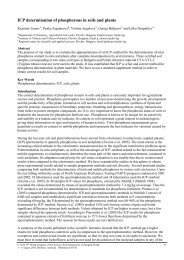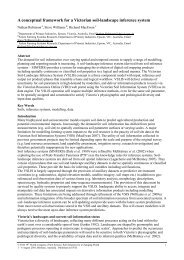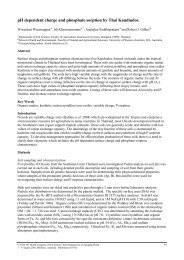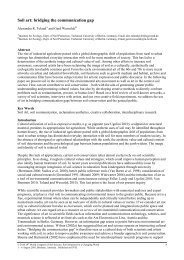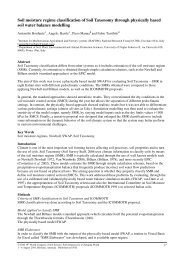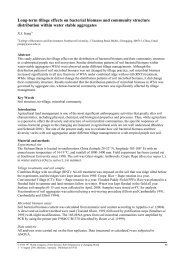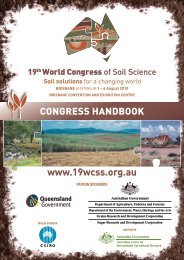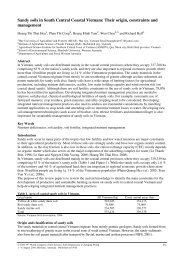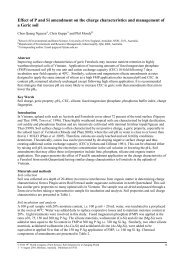Rab Abdur - International Union of Soil Sciences
Rab Abdur - International Union of Soil Sciences
Rab Abdur - International Union of Soil Sciences
You also want an ePaper? Increase the reach of your titles
YUMPU automatically turns print PDFs into web optimized ePapers that Google loves.
available water capacity (PAWC) was determined as the difference FC and PWP. <strong>Soil</strong>s were classified<br />
according to the Australian <strong>Soil</strong> Classification - ASC (Isbell 2002).<br />
Each soil property was modelled using residual maximum likelihood (ReML) based on a two-factor linear<br />
mixed model. The two factors were soil type (S, three levels) and soil depth (D, two levels). Wald tests were<br />
used to assess the significance <strong>of</strong> differences in soil properties between soil types, soil depths, as well as their<br />
interactions. All statistical analyses were conducted using GenStat 10.2 (Payne et al. 2007). The residuals<br />
reasonably satisfied the ReML assumptions <strong>of</strong> normality and constant residual variance. To study the effect<br />
<strong>of</strong> soil texture group on PAWC, data was analysed using one-way analysis <strong>of</strong> variance (ANOVA).<br />
Figure 1 Location <strong>of</strong> study sites in the southern Mallee and Wimmera regions, SE Australia<br />
Results<br />
Three major ASC soil suborders: Red Sodosols (RS), Hypercalcic Calcarosols (HYC) and Grey Vertosols<br />
(GV) were identified in this study area with nine soil texture classes were represented amongst these. There<br />
was a wide variation in soil texture across the three suborders; the RS dominated by coarse textures in the 0-<br />
10 cm and both coarse and medium textures in the 20-30 cm depth range; the HYC dominated by medium<br />
and fine textured soil in the 0-10 cm and 20-30 cm depth ranges respectively, and the GV dominated by fine<br />
textures.<br />
Mean values <strong>of</strong> FC and PWP for three soil types are presented in Table 1. The effect <strong>of</strong> interaction (soil x<br />
depth) and soil suborder on FC and PWP was significant (p0.05). However, a plot <strong>of</strong> mean values shows that the nature <strong>of</strong> interaction was <strong>of</strong> a noncrossover<br />
type (data not shown) and at both depths, mean values for RS were consistently low compared to<br />
both HYC and GV. The LSD test showed that at 0-10 cm depth, differences in FC and PWP between soil<br />
types were significant while at 20-30 cm depth the difference in FC and PWP between HYC and RS was not<br />
significant. The LSD test also showed that for GV the FC and PWP was not significantly different between<br />
two soil depths while for HYC and RS the differences between depths were significant.<br />
Table 1. FC, PWP and PAWC <strong>of</strong> three soil suborders at two depths in the Mallee and Wimmera<br />
regions <strong>of</strong> north-west Victoria, SE Australia.<br />
Volumetric soilwater<br />
A<br />
<strong>Soil</strong><br />
types (S) B Model<br />
Depth (D, cm) Mean term F Prob SEd<br />
0-10 20-30<br />
FC (% vol) HYC 34 42 38 S



